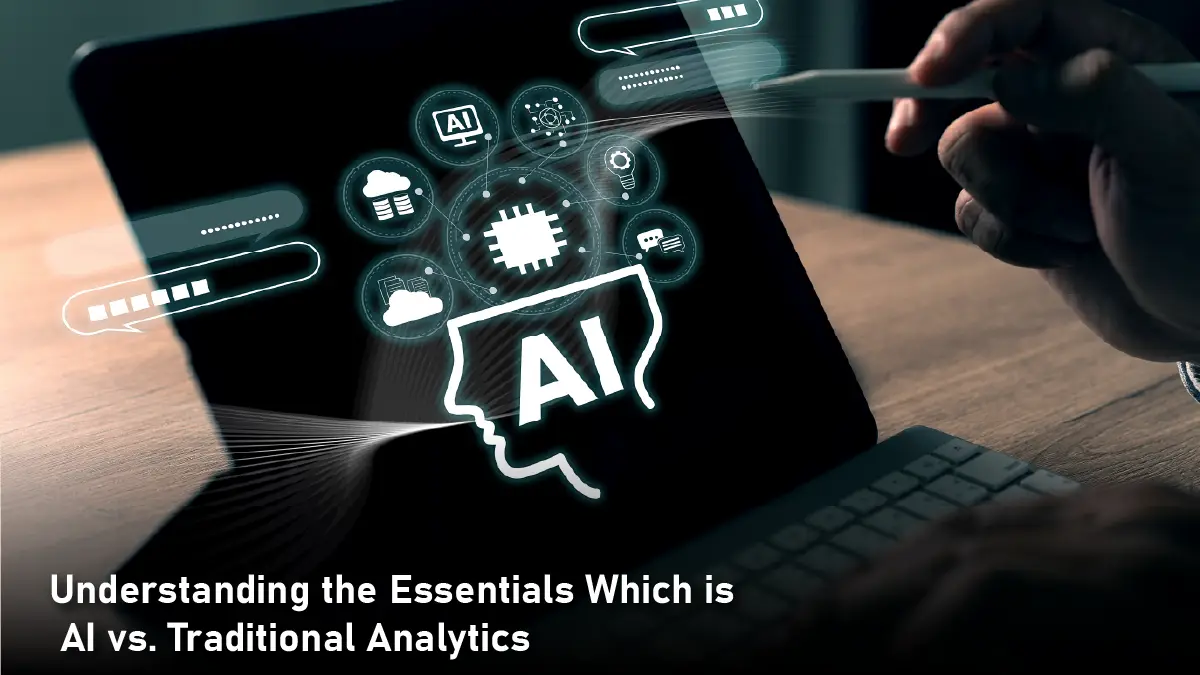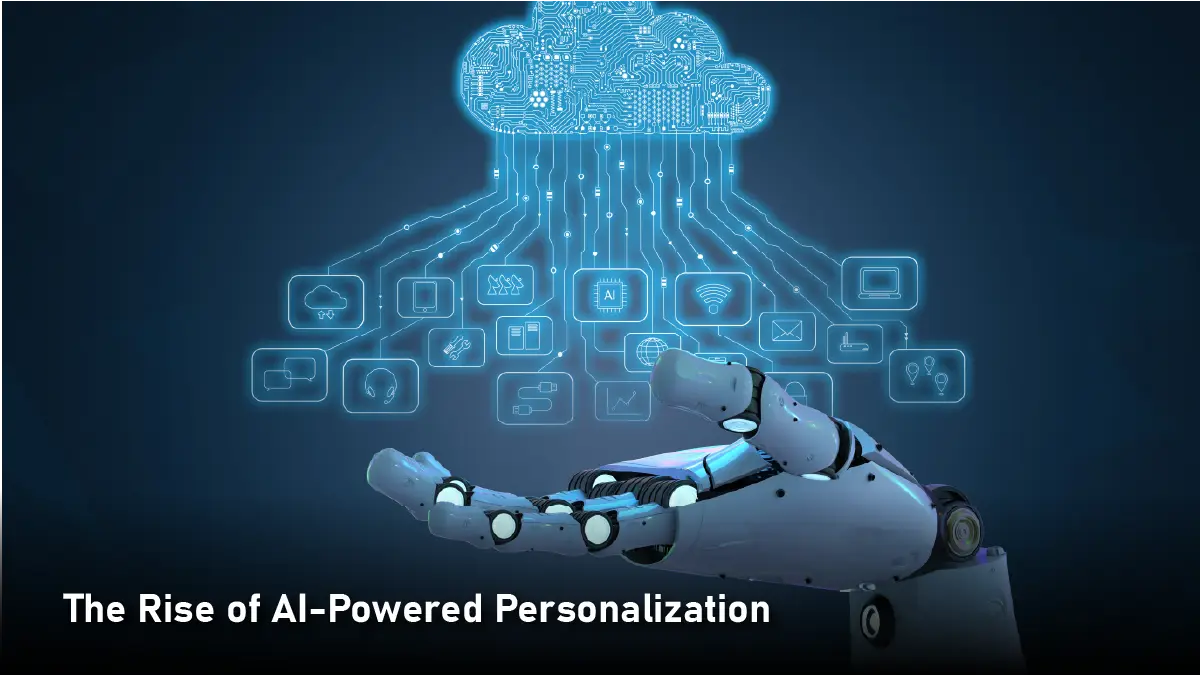Today’s businesses thrive on personalized experiences, and smart data use is key. Personalization boosts customer engagement through curated recommendations, tailored messages, and custom content. Companies now have an important choice: stick with traditional analytics or embrace AI innovations?
This guide compares AI and traditional analytics. It looks at their strengths and weaknesses. Each approach boosts personalized user experiences. This helps you make a smart choice. In the end, you’ll know how to pick the best approach for your organization.
Moreover, companies implementing personalization strategies see a 1.7x higher year-over-year growth in revenue compared to those that don’t. Personalized calls-to-action convert 202% better than basic CTAs.
Understanding the Essentials Which is AI vs. Traditional Analytics

Traditional Analytics relies on the art of structured data analysis. It employs descriptive, diagnostic, and inferential statistics. These methods are driven by human hypotheses and set models for extracting insights. AI, like machine learning and deep learning, helps computers learn from large datasets. AI can independently identify patterns without direct programming.
These smart systems evolve over time, enhancing their performance with every data interaction. Both strategies seek to reveal insights from data, but they do so in different ways.
The Case for Traditional Analytics in Personalization
Traditional analytics has been a reliable workhorse for decades. Here are some compelling reasons businesses still rely on it for personalization:
- Transparency and Interpretability: Traditional analytics offers clear, explainable insights. Marketing teams can clearly see and explain their decisions when they use regression models.
- Simplicity and Speed: Traditional analytics is faster to set up and easier to handle. This is great for companies with fewer resources or simpler data. Grouping users by age or location is basic personalization. It doesn’t require complex AI systems.
- Data Governance and Compliance: Traditional methods offer stronger control over data inputs and processes. This control helps when following privacy rules like GDPR or CCPA.
- Cost-Effective: Traditional analytics usually has lower upfront costs. It doesn’t need advanced infrastructure or special talent.
Real-World Example: A local retail chain can look at past sales data. This helps them find busy shopping times. Then, they can adjust their promotions to match. These insights come from simple statistical methods. They can provide a big ROI without needing a large investment in AI.
Also Read: How to Build a First-Party Data Strategy Before Google Kills Cookies
The Rise of AI-Powered Personalization

AI is rewriting the rulebook on personalization, crafting real-time experiences that astound. Here’s how it eclipses traditional analytics:
- Scalability and Automation: AI thrives on large datasets, quickly analyzing millions of data points. Customer behavior, demographics, and preferences are all part of the equation. It’s a boon for large companies with sprawling user bases.
- Predictive and Prescriptive Insights: Traditional analytics offers a rearview mirror glimpse. AI looks ahead, predicting ‘what will happen’ and suggesting actions. This proactive strategy keeps businesses a step ahead of customer needs.
- Continuous Learning: AI models are perpetual learners, refining themselves over time. AI systems improve suggestions as users interact online. This creates a feedback loop. It improves personalization and makes it more precise.
- Real-Time Personalization: Imagine Netflix curating your next binge based on past views. Or think of Amazon unveiling products that sync perfectly with your recent searches. All this happens in the blink of an eye.
- Improved Customer Segmentation: AI reveals hidden patterns and micro-groups that traditional analytics overlook. This precision targeting paves the way for richer customer experiences.
Real-World Example: Spotify creates custom Discover Weekly playlists. Each week, users enjoy a new curated playlist. It does this by looking at listening habits, user likes, and music features. Traditional analytics can’t do this as effectively.
Key Differences Between AI and Traditional Analytics
| Features | Traditional Analytics | Artificial Intelligence |
| Data Handling | Structured data | Structured & unstructured data |
| Speed | Slower, manual | Fast, automated |
| Learning Ability | Static models | Adaptive learning models |
| Personalization Level | Basic segmentation | Hyper-personalization |
| Interpretability | High | Often a ‘black box’ |
| Scalability | Limited | High |
Challenges and Considerations
While AI offers superior capabilities, it’s not without challenges:
- Data Quality: AI relies heavily on high-quality, diverse datasets. Inaccurate or biased data can lead to flawed personalization.
- Ethical Concerns: AI can unintentionally reinforce biases or invade user privacy. Transparent algorithms and ethical AI practices are essential.
- Talent and Infrastructure: The need for skilled data scientists and solid infrastructure to use AI is high. Smaller organizations might not have these resources or the ability to maintain them.
- Interpretability Issues: Many AI models are ‘black boxes.’ This makes it hard to explain how they make decisions. This lack of transparency can be problematic in regulated industries.
Traditional analytics might struggle to capture the full complexity of user behavior. They also may not adapt quickly to changing preferences.
Which is Better for Personalization?
The answer isn’t black and white. The best approach depends on your business size, goals, data maturity, and resources.
When to Use Traditional Analytics:
- You’re just beginning your personalization journey
- Your data is limited or highly structured
- You require full transparency and explainability
- Budget constraints limit tech investment
When to Choose AI:
- You have large, diverse datasets
- Real-time personalization is a priority
- Your audience expects hyper-relevant experiences
- You’re prepared to invest in AI infrastructure and talent
Hybrid Approach: Many successful organizations combine both methods. They use traditional analytics for strategic planning and AI for real-time execution. This hybrid approach offers the best of both worlds: interpretability and intelligence.
Actionable Insights for Implementation
Elevate your personalization game with these key strategies:
- Conduct a Data Audit: Dive deep into your data. Discover what you have, where it goes, and its quality.
- Set Clear Personalization Goals: Define your destination. Do you wish to retain customers, enhance conversions, or increase engagement? This clarity will steer your tool choices.
- Launch Pilot Projects: Start small with targeted AI personalization trials. Then, watch your efforts grow.
- Prioritize Ethics and Compliance: Uphold user privacy like a sacred trust. Follow regulations while crafting personalized experiences.
- Boost Your Team’s Skills and Tech: Arm your team with essential skills and cutting-edge tools. Blend traditional methods with AI mastery for unstoppable success. Make sure they can work effectively.
Final Thoughts
AI and traditional analytics are in a fierce battle, but it’s clear that both are essential. Traditional analytics offers a strong base. It gives organizations clear and easy-to-understand insights. AI excels with its precision, inviting bold pioneers to explore its complexities. A smart approach blends both strengths. It aligns new technology with business needs. This helps create effective, ethical, and scalable strategies. Future-readiness is no longer a luxury, it’s a must. Personalization has become an expectation, not a perk. The goal is clear: we want to give every customer great value. This applies to both classic analytics and advanced AI.


Comments are closed.